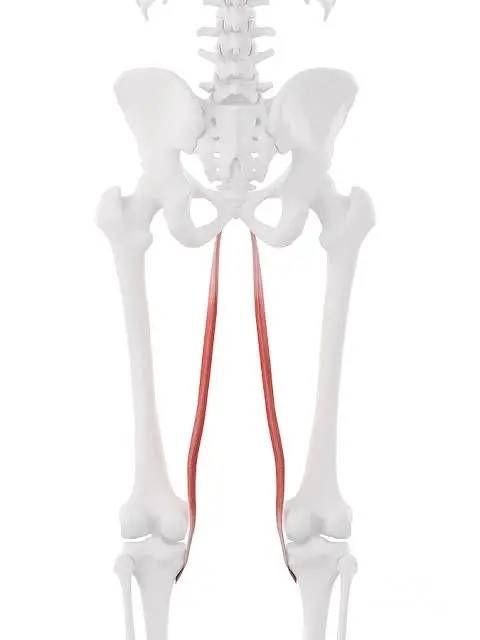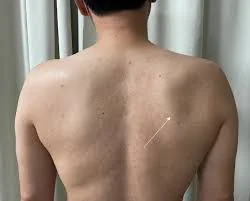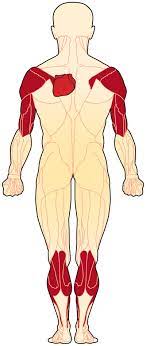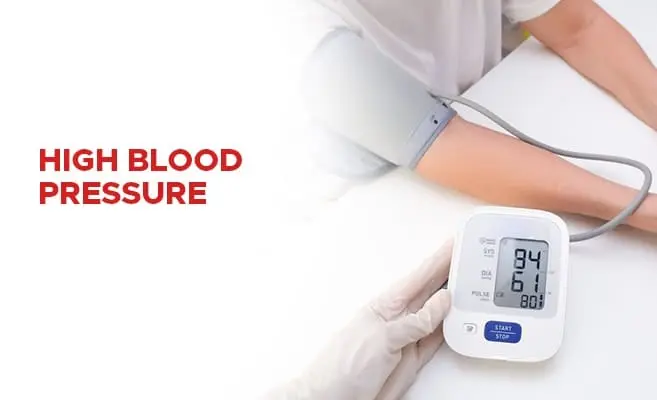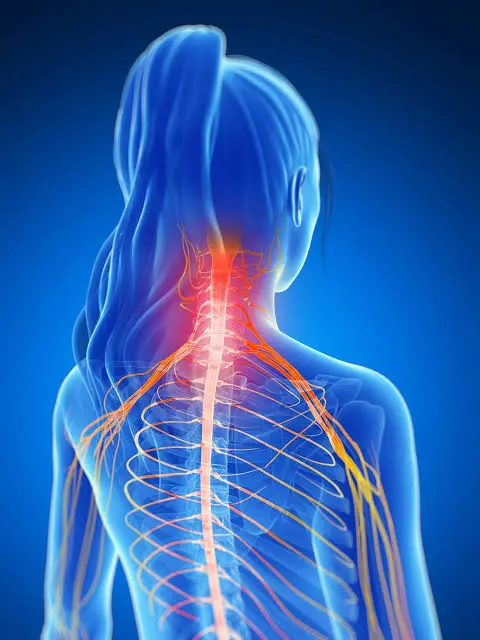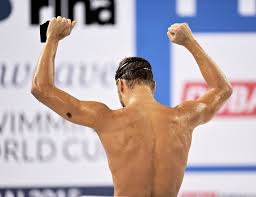Gracilis Muscle Pain
Table of Contents
What is a Gracilis muscle pain?
Pain that develops where the inside of the upper thigh and the abdomen meet at the same time is known as gracilis muscle pain. It is not the same as testicular pain, however, occasionally that can result in groin pain as well.
However, there are different ways that gracilis pain manifests, and groin pain can result from more than just damaged muscles. The diagnosis and course of treatment will be determined by the symptoms, underlying cause, and gender of the patient (child, adult, or woman).
Anatomy of gracilis muscle
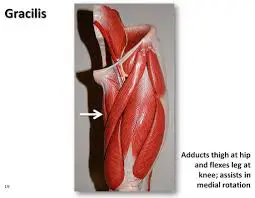
- It aids in internal rotation, flexion, and adduction of the hip.
- The obturator nerve’s anterior branch innervates it.
- crosses over at the knee and hip joints.
- Adductor tendinopathy can arise from strain injuries to the gracilis. Example typical among athletes in football, basketball, hockey, and soccer
Origin of gracilis muscle
The pubis and the ischiopubic ramus inferior side are the origin of the gracilis muscle.
Insertion of gracilis muscle
The gracilis muscle inserts on the medial tibia at the Pes anserinus after descending the leg nearly vertically. The Sartorius and Semitendinosus attach to the pes anserinus as well.
Nerve supply of gracilis muscle
The anterior branch of the obturator nerve innervates the gracilis muscles (L2-L4). The adductor longus and, on occasion, the adductor brevis are also innervated by the anterior branch of the obturator nerve.
The gracilis muscle contains five to seven muscle fiber bundle compartments. Nerve branches go through each compartment, suggesting the possibility of autonomous neuromuscular compartment activity.
Arterial supply of gracilis muscle
The medial circumflex femoral artery
Function of gracilis muscle
The gracilis flexes the knee, adducts the thigh, and medially rotates the tibia on the femur because of its attachment to the tibia.
Causes of Gracilis muscle pain
- Strain in the Groin
Your gracilis may tear from an abrupt push or pull, resulting in a strain on your groin area. The injury, which is often referred to as a groin pull, can result in the inner thigh and groin pain, bruising, and weakening.
The degree of a groin strain can vary from grade 1, which is a minor tear or stretch, to grade 3, which is a total rupture of the muscle.
- Spasms in the muscles
Involuntary muscular contractions, known as spasms, can range in severity from minor to incapacitating. The spasms can induce severe, protracted stiffness or throbbing (called cramps). It will give a very uncomfortable feeling while doing regular everyday activities.
Spasms in the gracilis muscle can be brought on by neurological (nerve-related) diseases including multiple sclerosis or stroke. Overuse of muscles, like that which happens when playing football, can also cause spasms. athletes in basketball, football, and hockey who overstretch their inner thigh muscles.
- Stripped Nerves
Compression of nerves by an accident or ailment affecting the lumbar spine results in pinched nerves sometimes referred to as radiculopathy.
The lumbar spine, which consists of the lower back’s five vertebrae, is highly densely packed with nerves that supply the gracilis muscle and other leg muscles. In addition to pain, compression of these nerves may result in muscle weakening.
Among the frequent reasons for radiculopathy are:
- An injury to the lower back
- Disc herniation
- Degeneration of the lumbar disc
- Arthritis of the lumbar facet
- Hernia in sports person
Sports hernias can result from engaging in activities that require abrupt changes of direction. A strain or tears to the groin area’s ligaments, tendons, or muscle fibers are referred to as this condition.
- Bursitis of pes anserine
Bursitis may result from an irritated pes anserine bursa brought on by misuse or stress. The gracilis, Sartorius, and semitendinosus are the muscles that surround this bursal sac.
- Neurological problems
Common symptom of the neurological disease multiple sclerosis (MS) is muscle rigidity. Additionally, the Multiple Sclerosis Association of America states that this stiffness frequently manifests in the groin.
- pubic osteitis
Osteitis pubis, also referred to as gracilis syndrome, is an inflammation of the region around the pubic symphysis, which is the joint connecting the left and right pelvic bones. Groyne’s pain may result from this. Although it is uncommon, evidence suggests that some urological surgeries and medical treatments can result in osteitis pubis.
Risk factors of Gracilis muscle pain
- Sports requiring repetitive jumping, such as distance running, fencing, ice hockey, and weightlifting;
- Sports where the legs must be brought together, like gymnastics and horseback riding;
- Inadequate physical conditioning (strength and flexibility);
- Prior osteitis pubis;
- Prior sprain or pelvic injury;
- Prior stiffness or loss of motion in the hip;
- Prior hip injury
Signs of Gracilis muscle pain
- A gracilis muscle injury can also manifest as knee pain in addition to groin or thigh discomfort. Yet, gracilis dysfunction can also result in knee pain.
- There may even be bruising and muscular weakening, depending on the type of groin damage. For example, a strained groin can cause either symptom.
Symptoms of Gracilis muscle pain
Following the aggravating action, symptoms typically appear gradually and subtly before spreading to encompass the entire activity and resulting in persistent pain.
• Pain that worsens when pivoting on one leg, such as when kicking a ball, sprinting, jumping, climbing stairs, or making a sudden direction change while running; it also worsens when stretching, especially when separating the legs and thighs or when bringing the thighs or legs together against resistance.
• Tenderness, soreness, and swelling in the front of the pelvis that may spread to the inner thigh or groin
• Limping when running or walking, you may feel very uncomfortable in your groin while walking.
• Having trouble kicking or bending the hips
When to see a doctor for gracilis muscle pain?
- if your leg is immobile.
- It becomes impossible to bear weight on the leg if the groin and upper thigh change color.
- If you experience numbness, weakness, or tingling in your leg and groin area.
- if you get excruciating groin pain and swelling.
Diagnosis of Gracilis muscle pain
Before anything else, the physiotherapist must perform a patient history and identify the source of the discomfort. Upon assessment, there is pain with resisted adduction, decreased adductor strength, and tenderness to palpation with focal swelling of the adductors. Without imaging, the diagnosis can be made with focal findings on assessment by applying the Doha Agreement Classification System standards.
After a thorough clinical examination, imaging might be helpful in differential diagnosis or in ruling out certain conditions. In athletes experiencing adductor and pubic-related pain, abnormal radiological findings around the pubic symphysis, such as pubic bone marrow edoema, are common. In athletes without any symptoms, these radiological findings are also typical. When making a diagnosis, radiological evidence alone might not be appropriate because pathology is not always implied by morphology.
Palpation at the adductor insertion at the pubic bone, adduction against resistance (squeeze tests at 0° & 45°), and passive stretching of the adductor muscles are the methods used to evaluate the strength and gracilis muscle bilaterally.
Each patient experiencing groin pain needs to have a clinical assessment. The injured athlete should initially have their extremities inspected while standing to check their alignment. The hip joint’s range of motion and the groin and hip muscles’ flexibility may then be assessed by having the patient lie down. For all groin injuries, the diagnosis classification scheme provided by the Doha agreement should be followed.
X-ray
If a bone fracture is the cause of your gracilis pain, an X-ray can assist the doctor in identifying it. The most common method for diagnosing gracilis pain is X-ray. Images of the body’s internal systems are taken during this imaging test. The X-ray in this case can display the hip joint’s bone structure and anatomy. The best method for identifying the cartilage damage site is through X-rays. They may also exhibit joint space narrowing and bone spurs, two other signs of hip osteoarthritis.
CT scan
The medical professional may decide to use a computed tomography (CT) scan. Using a CT scan, many X-rays are taken and joined to create a three-dimensional image. Intestinal issues or other disorders of the abdomen and pelvis can also be examined with ultrasounds and CT scans.
Magnetic resonance imaging (MRI)
The soft tissue around the hip joint can also be examined with magnetic resonance imaging (MRI). A magnetic field and radio waves are used in an MRI to provide images of the inside body structures. Labrum, tendons, ligaments, and muscles can all be seen on an MRI.
An MRI may occasionally require contrast. You will assist in supporting the infusion of a certain kind of dye during this process. This makes it possible for little damage to the labrum and cartilage inside the joint to manifest.
Ultrasonography
Your doctor can request an ultrasound if they believe your groin pain is caused by an inguinal hernia or your testicles. Sound waves are used in ultrasounds to provide an image of the inside structures of the body.
Should a kidney stone be a potential cause, the
Hernia test
The patient will be asked to cough while the doctor puts one finger into the scrotum, the sac that houses the testicles. The act of coughing causes the abdominal pressure to rise, forcing the intestines through the hernia opening.
Squeeze test
Before anything else, the physiotherapist must perform a patient history and identify the source of the discomfort. Upon assessment, there is pain with resisted adduction, decreased adductor strength, and tenderness to palpation with focal swelling of the adductors. Without imaging, the diagnosis can be made with focal findings on assessment by applying the Doha Agreement Classification System standards.
After a thorough clinical examination, imaging might be helpful in differential diagnosis or in ruling out certain conditions. In athletes experiencing adductor and pubic-related pain, abnormal radiological findings around the pubic symphysis, such as pubic bone marrow edoema, are common. In athletes without any symptoms, these radiological findings are also typical. When making a diagnosis, radiological evidence alone might not be appropriate because pathology is not always implied by morphology.
Treatment of Gracilis muscle pain
The RICE Model for gracilis muscle pain
The RICE approach applies to the first stage of pain comfort:
R-rest: When discomfort arises, stay away from activities that could aggravate the injury or cause more pain. so that takes a short break or does the bare minimum of exercises that need the adductor longus muscle, which is used to propel walking and running.
I-Ice: After applying ice to the area of discomfort for ten minutes, the pain and swelling subside. Frozen peas and cold packs are further options.
C-compression: A compression dressing used to relieve muscle strain and edoema.
E-elevation: To reduce swelling, the patient is raised to the afflicted leg with the use of a pillow.
Non-operative treatment should be tried for several months and is generally successful.
Medical treatment of gracilis muscle pain
To lessen inflammation, nonsteroidal anti-inflammatory drugs (NSAIDs) like ibuprofen and aspirin are frequently advised; however, do not take them within seven days before surgery. As instructed by your doctor, take these. In the event of bleeding, upset stomach, or indications of an allergic reaction, get in touch with your doctor right away. Acetaminophen is one of the other mild painkillers that can be utilised. Topical creams could be useful.
• If needed, prescriptions for painkillers may be issued. Use just as prescribed and as much as necessary. Usually prescribed only as a post-operative pain reliever.
• Corticosteroid injections can be used to lessen inflammation, but they are often not used for recent injuries.
Heating therapy in gracilis muscle pain
Apply heat with a warm water bottle and heating pad until the patient feels calm in the groin area, after two to three days of muscle soreness and the disappearance of the bump.
But always remember to look after this. Because the heating pad seems to burn, avoid sleeping with it on your skin.
Exercise of gracilis muscle pain
There are several therapy options available for those who experience pain in the gracilis muscle. Depending on your unique symptoms and demands, the best option for you may be physical therapy, stretching exercises, medication, or injections. Physical therapy will assist in teaching appropriate forms for exercises like walking, running, or jumping as well as strengthening muscles and enhancing posture to ease tension.
When recovering from an injury to the gracilis muscle, exercise and stretching are the primary methods employed. A safe and advanced program can be created with assistance from a physical therapist.
Stretches of gracilis muscle
The following easy stretches could be beneficial:
Butterfly stretch
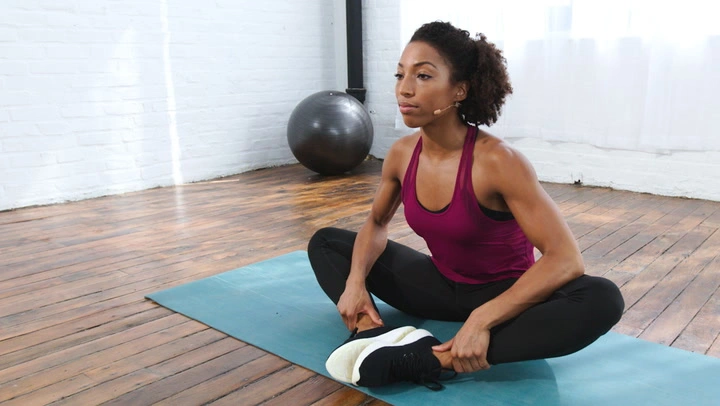
- Position yourself erect on the floor.
- Using your hands, clasp your feet together.
- Feel a tiny stretch in your knees as you gently bring them towards the floor.
- Stretching in this position for a duration of fifteen to twenty seconds.
- Let go and unwind.
- Five times over, repeat.
Squeeze Your Groin
- Take both of your knee joints of the body bent and supine on your back.
- Put a pillow or towel between your knees and roll it up.
- Squeeze the towel gently between your knees.
- Squeeze for five seconds.
- Ten times over, repeat.
Press up the lumbar spine
- Your hands should rest flat on the floor beneath your shoulders while you lie face down.
- As you progressively press your upper body up with your hands, bend your back as much as is comfortable while maintaining a relaxed hip and back.
- For two seconds, hold.
- Release gradually.
- Ten times over, repeat.
Knee to Chest position
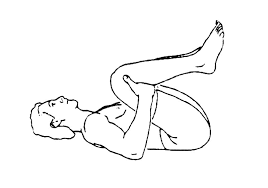
- Take both of your knee joints of the body bent and supine on your back.
- Lift your knees gradually and grasp with your hands.
- To bend your spine, gently bring your knees up to your chest.
- For two seconds, hold.
- Release gradually.
- Ten to fifteen times, repeat.
Lunge Stretch
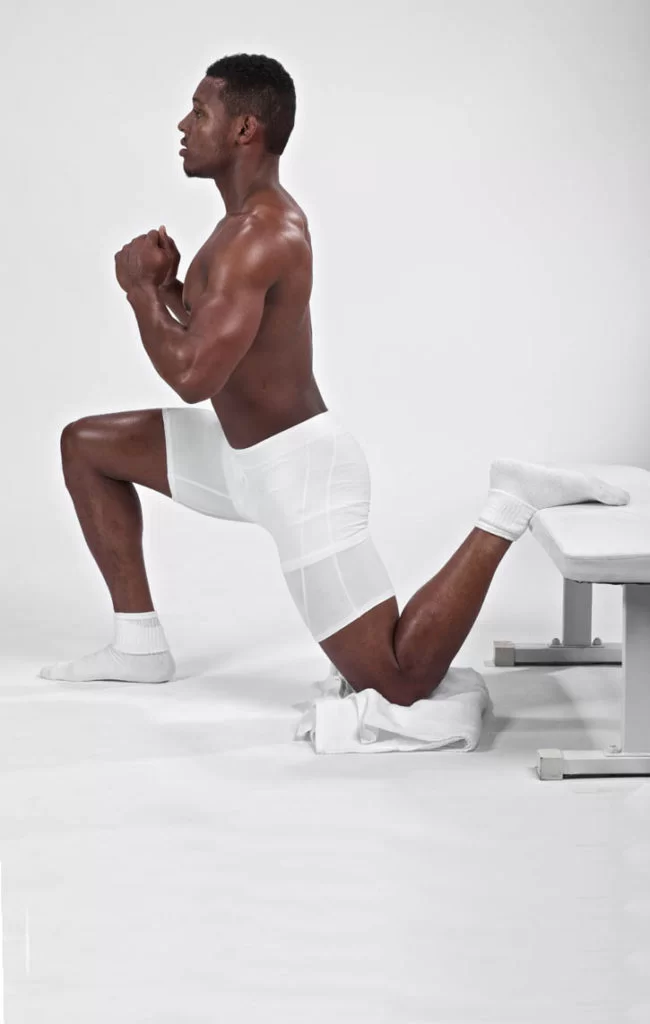
- Start in a lunge position while kneeling on the ground.
- To bring the outside of your shoulder nearer the inside of your lead knee, bend your torso forward.
- The hips should then slide forward as you lunge forward.
- Along the inside of the forwarding leg, you can sense a stretch.
- For five to ten seconds, hold this adductor stretch, then release it.
- Do ten to twelve repetitions.
Standing Lateral Lunge Gracilis Stretch
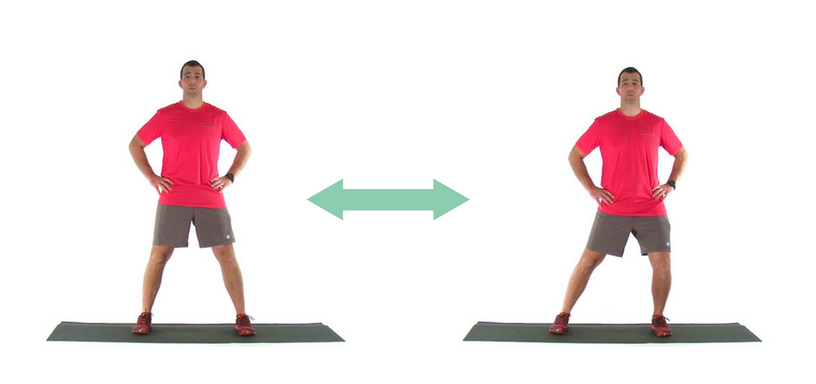
- Take a wide posture as you stand.
- Now shift your hips to that side and bend your knee.
- during the stretch, keep your posterior pelvic tilt in place.
- The inner of the opposing thigh is stretched.
- After five to ten seconds, release.
- As you advance, you can improve holding time.
- Stretch your adductors four or five times.
Gracilis AIS Release
- Start by lying down on your back with one foot wrapped in a resistance strap.
- The hand is placed over the other end of the strap.
- Next, firmly slide the foot to the side.
- To avoid the hip flexors contracting, slip the foot rather than raise it.
- Pull the foot further outwards with the resistance strap as the exercise comes to a close.
- The adductors feel stretched out.
- For five to ten seconds, hold the stretch, then slide back to start.
- Do 8–10 repetitions.
Supine Wall Stretch
- lying down facedown in front of a wall, with one leg propped up against the wall.
- Stride as close to the wall as you can while keeping your hamstrings at a comfortable length.
- Keep your leg straight as they gradually split open until you feel the tension in your muscles.
Standing stretch
- Place your feet about three feet apart as you begin to stand.
- Shift your weight to one side and flex your knee.
- To experience the feeling of a stretch on the underside of the thigh of the lower limb, keep the other knee straight.
- Stretching in standing for a time or duration between fifteen to twenty seconds.
- Remain calm and repeat on the opposite side.
Kneeling stretch
- Put your hands and knees on the ground to start.
- Stretching of your left side of the lower leg straight out to the one side. Aim to maintain the leg on the ground.
- Return your butt to your right bent knee’s heel.
- On the left inner thigh, you may feel the stretch.
- After 8–10 seconds of pausing, release the stretch and re-insert it.
- Do this eight to ten times.
Half kneeling dips
- With the left leg bent and the foot flat on the ground, begin in a half-kneeling position with the right knee on the floor.
- As much as possible, extend the left leg out to the side.
- There’s a chance your foot and knee are at a straight angle.
- Dive your body towards your left leg with your hands on your hips.
- The inner thigh is stretched, particularly on the right side.
- Do this eight to ten times.
Frogger stretch
- Stretching with frogger
- Start with your feet wider than your knees and forearms resting on the ground.
- Make an effort to keep your inner toes on the ground.
- Feel the stretch on your inner thighs as you sit with your butt back against your heels.
- After ten to fifteen seconds of pause, release
Lateral squat
- Place your feet two times shoulder-width apart and stand tall.
- As though you were sitting down, shift your weight to your left leg, bend your left knee, and push your hips back.
- Lower yourself as much as you can while maintaining a straight right leg.
- Maintain an elevated chest and your left leg’s weight.
- Take a breath and hold it for 15 to 20 seconds before stepping back into the starting position.
- After two or three repetitions, switch to the opposite side.
Crossover Stretch
- Step right with your right foot after starting with your feet together.
- Put both of your feet together.
- Repeatedly take a step to the right, then bring your left foot to meet your right foot.
- Once both feet are together, switch to the other side and repeat.
Seated Stretch of Adductor
- Stretch your legs straight out to the sides to form a “V” shape.
- Avoid overdoing this stance to avoid straining your joints.
- For numerous individuals, merely assuming this position suffices to provide an inner thigh stretch.
- Maintain a straight back and bend your hip joints towards the floor to feel extra stretch.
- Remain there for ten to fifteen seconds. respire regularly
Reclining angle bound pose
- On the surface of the floor, take a supine position.
- Your soles should contact each other at their boundaries when you bend both of your knees inward.
- Feel the muscles in your groin stretching as you bring your knees down towards your floor.
- Take a breath and maintain this posture for 15 to 30 seconds.
- Three to four times, repeat. With each stretch, aim to bring the feet in closer to the buttocks.
Hip Opener and Groin Stretch
- Drop your right knee to the floor and start in a forward lunge. As shown in the illustration, place your left elbow on the inside of your left knee.
- Twist your torso to the right and softly press your left elbow against your left knee.
- Extend your right arm behind you until your left groin and lower back start to gently stretch.
- Stretch for 20 to 30 seconds, then release it and repeat with your right leg.
Frog Squat With Arm Raise
- Putting the right hand down on the floor, go straight from the first stretch.
- Once you bring your left hand straight up to the roof with your fingers pointing upward, keep slowly pushing your inner thigh outward.
- Reach as high as you can and twist your upper body a little bit further with each breath.
- Your heel to the right
Runner’s Lunge
- Turn to face the front of the mat while on all fours.
- Gently press your hands into the ground while you extend your right leg behind you, keeping your knee slightly raised or resting.
- Push your right heel towards the direction of the room’s back.
- Align your left foot with your left hand by bringing it forward.
- Keep your head up.
- Breathe in and out, pressing your hips into the earth deeper with each breath.
- Proceed to the other
Strengthening exercise of gracilis muscle
Raise Your Legs Straight

- On the surface of the ground, take a supine lying position for exercise.
- With your foot flat on the ground, flex one knee. Set the other leg straight.
- Raise the straight leg as high as possible while maintaining a 45-degree angle.
- For three seconds, hold.
- Bring your leg down.
- Ten to fifteen times, repeat.
Hip Adduction While Standing and Using a Resistance Band
- Attach the resistance band to a leg of the table.
- Place your side facing the table as you stand.
- The ankle closest to the table leg should have the band around it.
- Your feet of the leg must be put shoulder-width apart from each other.
- Pull your leg gently in the direction of your body’s midline.
- For three seconds, hold, Release gradually.
- Ten to fifteen times, repeat.
Side-Lying Hip Adduction
- There isn’t a better ground exercise for the hip adductors that targets just one leg at a time like this one.
- To elevate your leg off the ground, all you have to do is concentrate on engaging the hip adductor muscles.
- You must perform this exercise while lying on your left side, placing your forearms and elbows on the floor for support. Elevate your right leg above your lower leg, pressing your heels up against the lower leg’s thigh.
- Keep your leg outstretched and raise it as high as you can.
- Return to the starting position slowly.
- Perform 10 to 25 repetitions on the left leg before switching to the right.
Squat Side Kick
- Exercise for the lower limbs that works both the adductors and the abductors is the bodyweight squat side kick.
- This workout has two motions that help to stretch and strengthen muscles, which is crucial to lowering the chance of developing groin pain.
- You must stand with your hands clasped in front of you and your shoulders hip-width apart to do the Squat sidekick exercise.
- Step up and shift your weight to your right leg while kicking out your left leg to the side. Flexion of your knees until your thighs of the body are parallel to the ground surface.
- Return to the squatting position and then do it with the other leg.
Note: Throughout the exercise, your core muscles may be used to keep your back straight, and your chest elevated, and you don’t fully extend.
Sumo Squat
- This squatting version targets the inner thighs as well as the lower limb muscular groups.
- Throughout the workout, keep your chest high and your back straight.
- The sumo squat is a useful exercise that may be added to regular workout routines, despite having a lower range of motion than a standard squat.
- You must point outside while standing wider than shoulder-width apart for this activity.
- Assume a squatting stance; lower your hips and back while maintaining a straight back and raise your chest until your thighs are parallel to the floor.
- Push through the earth to get back to where you were before.
Note: Hold a kettlebell in your hands if you want to add some provocation to your practice.
Cross Scissors
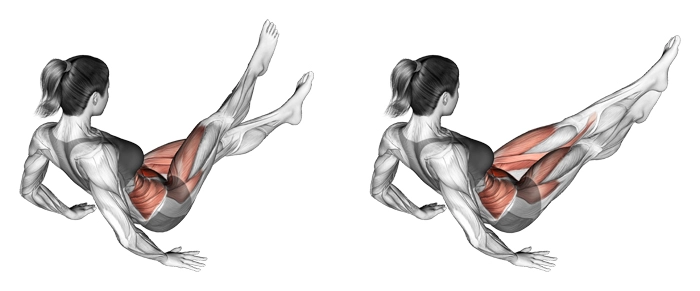
- The ideal exercise for concurrently working the hip adductor muscles and the core muscles is this one.
- Cross scissors are difficult because you have to maintain a tight posture the entire time.
- Keep your legs crossed position in front side of you. To do these exercises, contract and generate tension in all of your stabilizing muscles.
- You must sit down for this exercise and brace yourself by placing your hands back on the floor. Raise your leg off the floor in front of you and place one leg over the other at a 30 to 40-degree angle.
- Throughout the exercise, your core muscle may be used to maintain a semi-V position as you extend your legs to the sides and then bring them back together while crossing your other leg over.
- Continue doing this with a different leg until you’ve completed ten to twenty reps per side.
Note: By sitting in a “V” stance and not using your arms to support your upper limb, you can increase the difficulty of cross scissors.
Dumbbell Side Lunge
- A great exercise to increase your lower limb strength, stability, and balance is the side lunge.
- Exercises that involve side-to-side motion are both strengthening and stretching. The dumbbell side lunge exercise works the adductors and abductors of your hips.
- You must stand with your shoulders hip-width apart and the dumbbells at chest height to perform this workout.
- With your foot firmly planted on the ground, take a big step to your side and lower your hip down and back until your thighs are parallel to the floor.
- Push through your foot that is contracted and bring your position back.
Cossack Squat
- The Cossack Squat exercise involves side-to-side movement of the body in the frontal plane.
- Flexibility in the hips, knees, and ankles can be enhanced by working the lower limb at this position.
- Once you have mastered this exercise and can stretch and strengthen your hip adductors, you will have more stability.
- You must drop your hips back and downward and stand with your feet wide apart and your toes pointed outside for this exercise.
- With your heels on the floor and your toes facing upward, squat down to that one side and shift your weight with the other leg extended out.
- With your leg flexed, push through the ground to return to the starting position.
- Transfer the weight to the other leg and drop it to repeat this exercise.
Copenhagen Side Plank
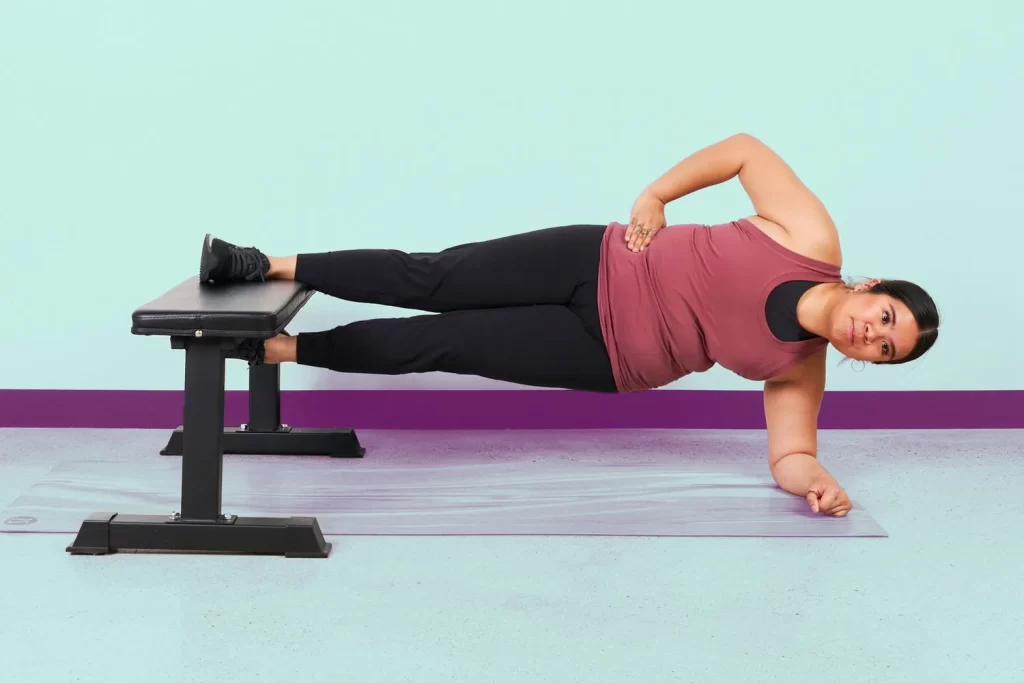
- The most challenging plank exercise is the Copenhagen Side Plank, which targets the hip adductors in addition to the core. An exercise that will assist in balancing out the strength in the muscles on the outside of the hip is the Copenhagen Side Plank.
- You must brace yourself on your forearms and elbows for this exercise, which requires you to lie on the floor perpendicular to the bench.
- Raise your upper leg and plant it on the bench by flexing your knee.
- Take up this role.
- After two sets of 20–25 repetitions, switch to the opposite side.
Note: You can make this workout harder by extending your legs and just placing your ankle on the bench.
Cable Hip Adductor
- You might observe that although the guys skip this activity at the gym, ladies perform it.
- It’s time to dispel the myth that cable hip adductions aren’t the main purpose of this exercise; in reality, anyone can use it to develop their adductors and lower their chance of injury.
- Before beginning this exercise, make sure you warm up with some dynamic stretches. Then, try starting with a lower weight and doing the maximum number of repetitions until you feel comfortable enough to move up to a higher weight.
- Locate an attachment that you can fasten to the ankle that is nearest the pulley.
- Place the pulley at the level of the calve. Place yourself beside the pulley. In a secure location where your fingers won’t get pinched, brace yourself by placing your hand against the machine. You may have your active leg raised off the ground in the direction of the pulley.
- Draw your leg towards your midsection, away from the pulley.
- Allow the leg to slowly revert to its initial position. reached the required amount of repetitions.
Note: By fastening a resistance band to a permanent anchor point, the same approach can also be used for exercise.
Seated Hip Adduction
- When seated, the seated hip adduction will isolate the hip adductor muscles, requiring simply that you concentrate on pulling your thighs together.
- When your leg day is almost over, incorporate some Seated Hip Adduction exercises after finishing the larger compound movements, like squatting.
- Place your back on the backrest of the machine seat.
- Adjust the knee pad width to a comfortable level that stretches the inner thighs without overstretching the adductor muscles.
- To avoid overdoing it, set up a lightweight for the first set.
- Exhaling, squeeze your thighs together until your knees meet in the middle of your torso.
- Return to the starting position slowly.
- Perform all of the possible repetitions.
Adductor machine
- When most individuals consider isolating the adductors, they might picture the traditional adductor machine seen in gyms all over the world.
- While the adductor can be most effectively trained with this machine, other movements can also provide positive effects.
- This workout is excellent for beginners since you may adjust the width of the pads and the amount of weight. To gain a sense of the workout and prevent injury, it is best to start extremely light.
- To perform this workout, you must first sit on the machine, spread the cushions as wide apart as comfortable, and choose the resistance level that suits your capacity.
- Contract your thighs together carefully until the pads make contact with each other. After some time it needs progression of treatment.
Wide stance squat
- The best leg workout is squatting, which will work your entire leg.
- There are other squat varieties, but in this case, we’ll focus on the wide stance squat, often known as the sumo squat, which works the muscles in your inner thighs.
- This exercise can be performed using only your body weight or several weighted tools, such as a barbell, kettlebell, dumbbell, or sandbag.
- You must turn your toes outside and stand somewhat wider than shoulder-width apart to perform the wide-stance squat exercise.
- Once your thighs are parallel to the ground, softly lower your hips and shift your weight rearward.
- Then, with your inner thigh muscles clenched, push through the ground to return to the starting position.
- Perform ten to fifteen repetitions of exercise.
Seated Banded Adduction
- You will need a resistance band for the Seated Banded Adduction Exercise. keep the band surrounding the sturdy anchor.
- You must face the anchor point and the resistance band while seated on the bench on each side of your torso.
- Position the resistance band directly below the knee joint and insert the internal foot through it. Permit the leg to be drawn towards the anchor point by the resistance band.
- Pull your leg towards your midsection by tensing your adductor muscle.
- Do this for every leg.
- Perform 12–15 repetitions in 2-3 sets.
Lateral Lunge
- You must stand with your feet hip-width apart to perform the Lateral Lunge exercise. As you flex your left knee, step out of your left leg and begin by sending your hip back.
- If you would like, you can counterbalance by extending your arms forward. Your knee should stay between your second and third toes during the drop, moving no more than two inches past them.
- The toe somewhat extends outward. Push off through to the left to get back to the beginning.
- To finish the first set of repetitions, repeat on the right leg.
- Perform 3–4 sets of 8–10 repetitions for every leg.
Benefits of the Gracilis Muscle Exercises
It’s common practice to ignore the gracilis during strengthening workouts, but this is incorrect. You run the risk of getting groin injuries if you don’t strengthen these muscles.
We go over a few advantages of performing hip adductor workouts below.
Better Equilibrium
Exercises that improve balance assist us in maintaining our upright posture when performing abrupt lateral movements. Unilateral hip adductor exercises are also recommended because they target the tiny muscles and enhance balance.
Increased Rotational Power
Our bodies can generate more rotational power when we have strong hip adductors. These adductor muscles help to sustain some of the rotational power and torque needed for the internal rotation of the hips, which is necessary in sports like baseball and tennis.
Boost Hip Extension
Squats and deadlifts are two major compound movements in which hip extension is crucial. Including hip adductor exercises in your regular training regimen will help you carry heavier objects, perform better in sports, and simplify daily tasks.
Lower Risk of Injury
Sportsmen and even people in regular life frequently suffer groin pulls. Tight or weak hip adductors are the cause of groin strains. The risk of this injury can be reduced by stretching and strengthening the adductor muscles.
This muscle group is very important to athletes since it facilitates explosive motions like running, jumping, and fast side-to-side motion.
Prevention of gracilis muscle pain
• Continue with the proper conditioning:
• Muscle strength and endurance;
• Flexibility of the hips and thighs;
• Maintain cardiovascular fitness;
• Apply appropriate athletic technique.
Complication of gracilis muscle pain
- Long-term recovery if the injury is not properly cared for or is not given enough time to heal;
- Symptoms and injury reoccur if activity is resumed too soon;
- Injury progressing untreated to a full tear (rare) or other injuries because the afflicted leg is favoring and limping; extended disability, aggravation of pain lead to deformity and spasm in the muscles. Which is known as reflex spasm of the muscle. Which occur due to pain.
Summary
The gracilis muscle extends from the bottom of the inner knee to the inner thigh and inner groin. It facilitates hip adduction, the motion of drawing your legs together. Additionally, it aids in the inward and outward rotation of your thighs and stabilizes your bent knee.
The gracilis muscle is prone to ailments such as pinched nerves that can result in discomfort and weakening, groin strains, and muscular spasms. Pain management drugs, physical therapy, and mild stretches and exercises can all be used to address these ailments.
The gracilis syndrome is characterized by a traumatic fatigue avulsion fracture involving the gracilis muscle’s bone origin at the pubic symphysis.112 The clinical presentation resembles that of pubic osteitis. Patients usually present with subtle onset persistent discomfort in the medial thigh, perineal area, and groin. The gracilis muscle is frequently the path along which the pain radiates. Upon physical examination, the pubic symphysis is covered in localized discomfort. A bone fragment next to the symphysis at the inferior corner of the pubis is seen on plain radiography. According to histopathology examination, the fragment may have been caused by an avulsion type of fatigue fracture, where the avulsion is connected to the gracilis muscle’s directional pull. It is advised to treat no operatively wherever possible, but if that fails, surgery is required.
FAQs
Though they can be excruciatingly painful, they heal in about six weeks.
straining in the groin. The groin muscle is strained or stretched in this condition.
Hernia in sports. Engaging in sports involving abrupt direction shifts may result in sports hernias.
A compressed nerve.
Neurological problems; muscle spasms; pes anserine bursitis;…
pubic osteitis and many other problems related to it.
The adductor group of muscles, which aids in leg crossing and maintains pelvic balance during walking and standing, is located on the medial side of the thigh.
Because it laterally rotates and abducts the thigh, causing the vagina of the female to wide open.
References
Gracilis. (n.d.). Physiopedia. https://www.physio-pedia.com/Gracilis
Pt, B. S. (2023, June 29). The anatomy of the Gracilis muscle. Verywell Health. https://www.verywellhealth.com/gracilis-muscle-anatomy-4774807#toc-associated-conditions
Gracilis Muscle pain: causes, stretches, strength exercises | ISSA. (n.d.). https://www.issaonline.com/blog/post/gracilis-muscle-pain-causes-stretches-strength-exercises
Nora. (2022, December 28). Gracilis Muscle Pain: What Is It & How to Relieve It? Stretch.com. https://stretch.com/blog/gracilis-muscle-pain/#Common_Signs_You_May_Have_a_Gracilis_Injury
Valand, B. (2022, July 28). Gracilis muscle strain: Cause, Symptoms, Treatment, Exercise. Samarpan Physiotherapy Clinic. https://samarpanphysioclinic.com/gracilis-muscle-strain/#Diagnostic_Procedures
Thomsen, A. (2023, June 12). 3 stretches for a tight Gracilis muscle. ASFA. https://www.americansportandfitness.com/blogs/fitness-blog/3-stretches-for-a-tight-gracilis-muscle
Rupapara, D. (2023, January 6). Gracilis muscle pain. Mobile Physiotherapy Clinic. https://mobilephysiotherapyclinic.in/gracilis-muscle-pain/#Causes_of_Gracilis_muscle_pain
Hall, T. (2023, October 11). Gracilis Muscle Guide: Causes, stretches, and strengthening. ASFA. https://www.americansportandfitness.com/blogs/fitness-blog/gracilis-muscle-guide-causes-stretches-and-strengthening
Groin/High adductor strain: Causes, symptoms and treatment. (2023b, July 21). AIRROSTI. https://www.airrosti.com/injuries-we-treat/groin-high-adductor-strain/
Cook, M. (2023, October 21). Groin pain | gracilis muscle | Adductors | Inner thigh muscles. Body Ache Escape Massage Center. https://bodyacheescape.com/groin-pain/
Groin/High adductor strain: Causes, symptoms and treatment. (2023, July 21). AIRROSTI. https://www.airrosti.com/injuries-we-treat/groin-high-adductor-strain/

